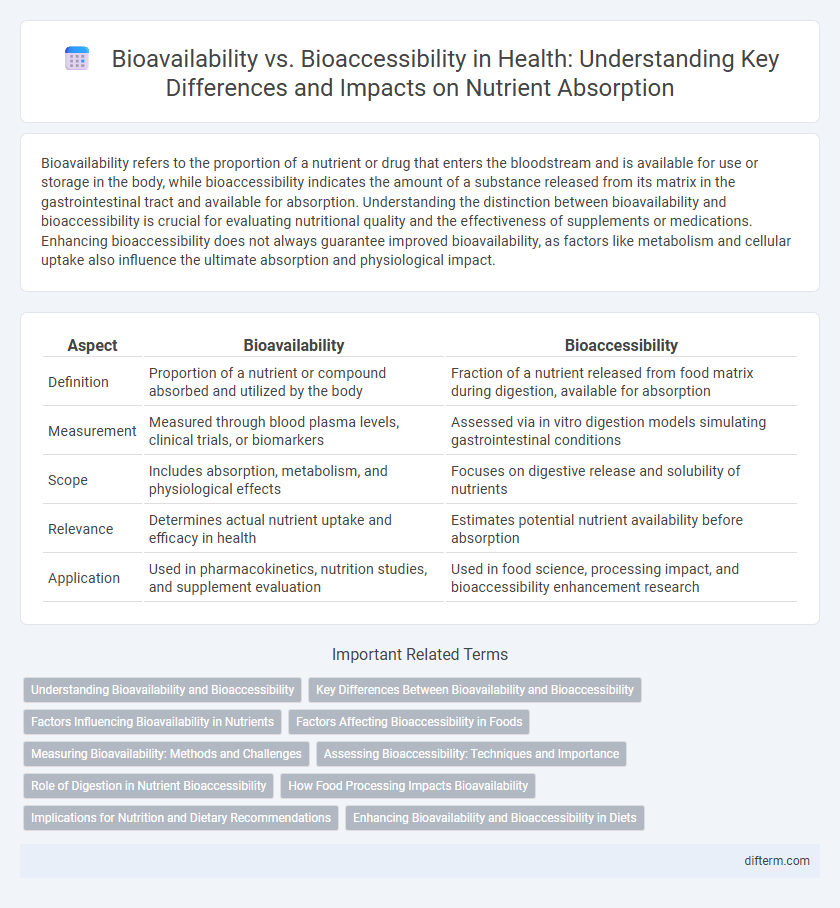Bioavailability refers to the proportion of a nutrient or drug that enters the bloodstream and is available for use or storage in the body, while bioaccessibility indicates the amount of a substance released from its matrix in the gastrointestinal tract and available for absorption. Understanding the distinction between bioavailability and bioaccessibility is crucial for evaluating nutritional quality and the effectiveness of supplements or medications. Enhancing bioaccessibility does not always guarantee improved bioavailability, as factors like metabolism and cellular uptake also influence the ultimate absorption and physiological impact.
Table of Comparison
| Aspect | Bioavailability | Bioaccessibility |
|---|---|---|
| Definition | Proportion of a nutrient or compound absorbed and utilized by the body | Fraction of a nutrient released from food matrix during digestion, available for absorption |
| Measurement | Measured through blood plasma levels, clinical trials, or biomarkers | Assessed via in vitro digestion models simulating gastrointestinal conditions |
| Scope | Includes absorption, metabolism, and physiological effects | Focuses on digestive release and solubility of nutrients |
| Relevance | Determines actual nutrient uptake and efficacy in health | Estimates potential nutrient availability before absorption |
| Application | Used in pharmacokinetics, nutrition studies, and supplement evaluation | Used in food science, processing impact, and bioaccessibility enhancement research |
Understanding Bioavailability and Bioaccessibility
Bioavailability refers to the proportion of a nutrient or compound that is absorbed and utilized by the body after ingestion, while bioaccessibility indicates the fraction that is released from the food matrix and becomes available for absorption in the gastrointestinal tract. Understanding the distinction between bioavailability and bioaccessibility is crucial for evaluating the nutritional efficacy of dietary supplements and functional foods. Factors such as food composition, digestive health, and metabolic processes significantly influence both bioavailability and bioaccessibility outcomes.
Key Differences Between Bioavailability and Bioaccessibility
Bioavailability refers to the proportion of a nutrient or bioactive compound that is absorbed and utilized by the body, while bioaccessibility denotes the fraction of a nutrient released from the food matrix during digestion, making it available for absorption. Key differences include that bioaccessibility is a prerequisite for bioavailability, as compounds must first be accessible before they can be absorbed into systemic circulation. Measuring bioavailability involves complex in vivo studies, whereas bioaccessibility is often assessed through in vitro digestion models to estimate potential nutrient uptake.
Factors Influencing Bioavailability in Nutrients
Factors influencing nutrient bioavailability include the chemical form of the nutrient, the food matrix, and interactions with other dietary components such as fiber, fat, and phytates. Digestive efficiency and gastrointestinal health also play significant roles in determining the extent to which nutrients are absorbed into the bloodstream. Enzymatic activity, pH levels, and the presence of transport proteins further affect nutrient uptake and utilization in the body.
Factors Affecting Bioaccessibility in Foods
Bioaccessibility in foods is influenced by factors such as food matrix composition, digestion processes, and interactions with other dietary components. The presence of fibers, fats, and proteins can either enhance or inhibit the release of nutrients during gastrointestinal digestion. Enzymatic activity, pH levels, and food processing methods also play critical roles in determining the extent to which nutrients become bioaccessible for absorption.
Measuring Bioavailability: Methods and Challenges
Measuring bioavailability involves quantifying the fraction of a nutrient or drug that reaches systemic circulation and is available for biological effect, commonly assessed through pharmacokinetic studies and blood plasma analysis. Challenges in measuring bioavailability include interindividual variability, complex metabolic pathways, and the influence of food matrix and digestive processes on absorption. Advanced techniques such as isotopic labeling, in vitro digestion models, and computational simulations improve accuracy but require standardization for consistent results.
Assessing Bioaccessibility: Techniques and Importance
Assessing bioaccessibility involves techniques such as in vitro digestion models and simulated gastrointestinal fluids to estimate the fraction of nutrients or bioactive compounds released from food matrices and made available for absorption. These methods are crucial for understanding how effectively nutrients can be absorbed and utilized by the body, informing dietary recommendations and functional food development. Accurate bioaccessibility assessment bridges the gap between food composition and actual nutritional impact, enhancing personalized nutrition strategies.
Role of Digestion in Nutrient Bioaccessibility
Digestion plays a crucial role in nutrient bioaccessibility by breaking down food matrices to release bioactive compounds, making them available for absorption. Enzymatic actions in the gastrointestinal tract, including saliva, gastric, and pancreatic secretions, enhance the solubilization and transformation of nutrients into absorbable forms. The extent of nutrient liberation during digestion directly impacts bioaccessibility and consequently influences overall bioavailability.
How Food Processing Impacts Bioavailability
Food processing significantly influences nutrient bioavailability by altering the chemical structure and matrix of food, enhancing or reducing the absorption of vitamins and minerals. Thermal treatments like cooking or pasteurization can increase bioavailability of certain nutrients such as lycopene and beta-carotene while degrading heat-sensitive vitamins like vitamin C. Mechanical processes, including grinding and milling, improve bioaccessibility by breaking down cell walls, facilitating enzymatic activity and nutrient release for better absorption in the digestive tract.
Implications for Nutrition and Dietary Recommendations
Bioavailability measures the proportion of nutrients absorbed and utilized by the body, while bioaccessibility refers to the fraction of nutrients released from the food matrix during digestion. Differences between these concepts impact dietary recommendations by influencing nutrient intake assessments and supplementation needs. Understanding bioavailability over bioaccessibility ensures more accurate nutrition planning and effective prevention of nutrient deficiencies.
Enhancing Bioavailability and Bioaccessibility in Diets
Enhancing bioavailability and bioaccessibility in diets ensures that nutrients are effectively absorbed and utilized by the body, improving overall health outcomes. Strategies such as consuming nutrient-rich foods alongside natural enhancers like vitamin C, reducing anti-nutrient intake, and processing methods like soaking and fermenting can maximize the release and absorption of crucial vitamins and minerals. Optimizing these factors is essential for addressing nutrient deficiencies and supporting metabolic functions.
Bioavailability vs Bioaccessibility Infographic

 difterm.com
difterm.com